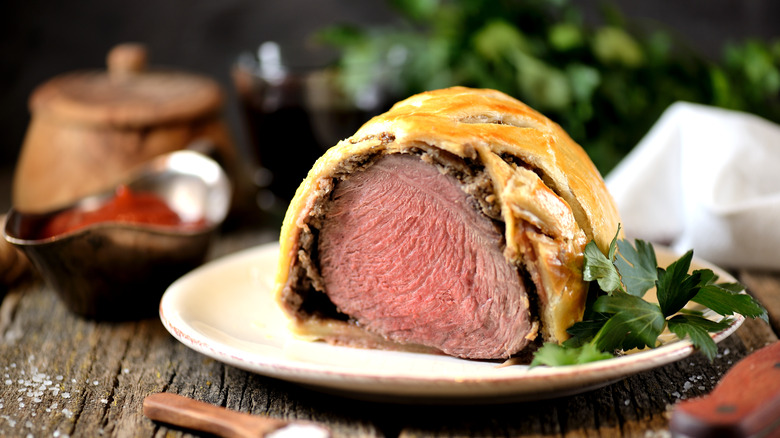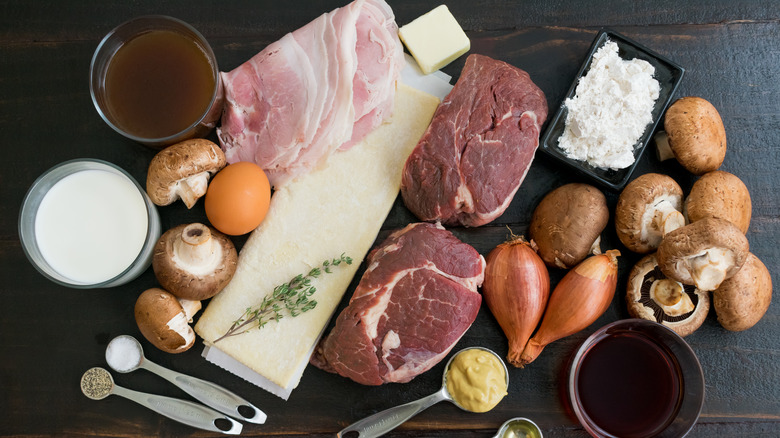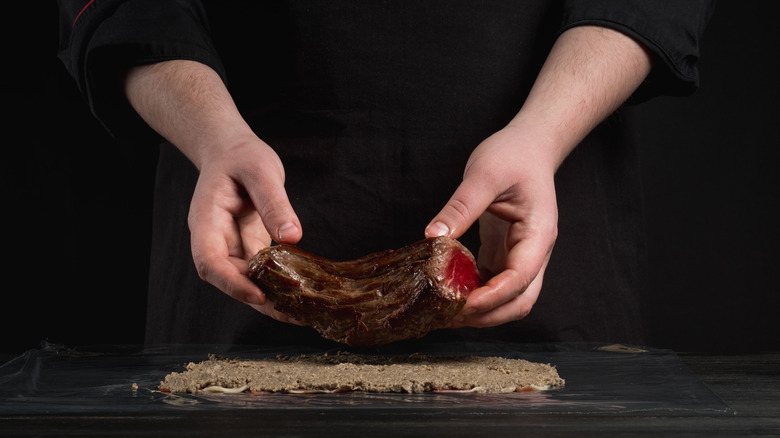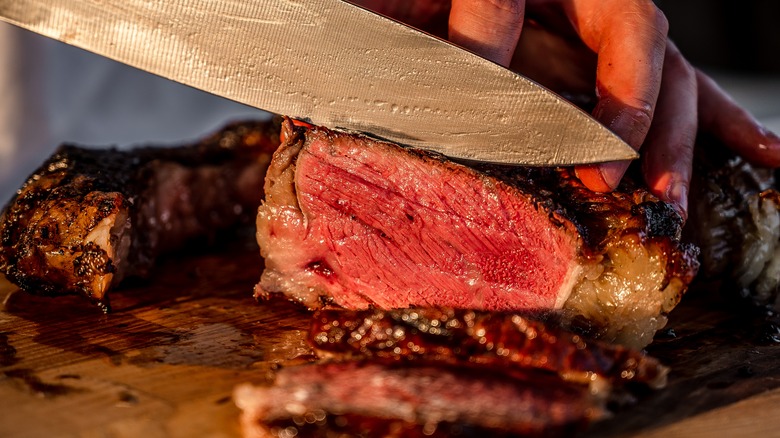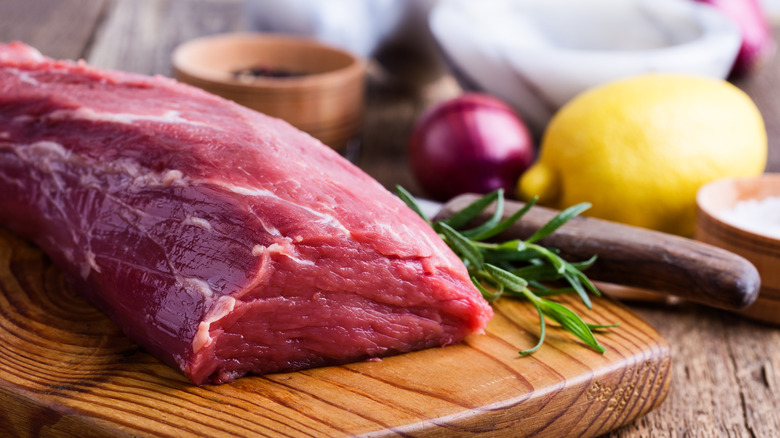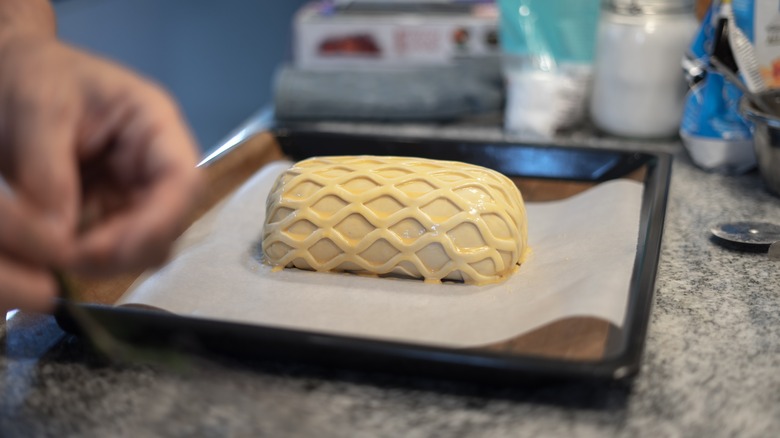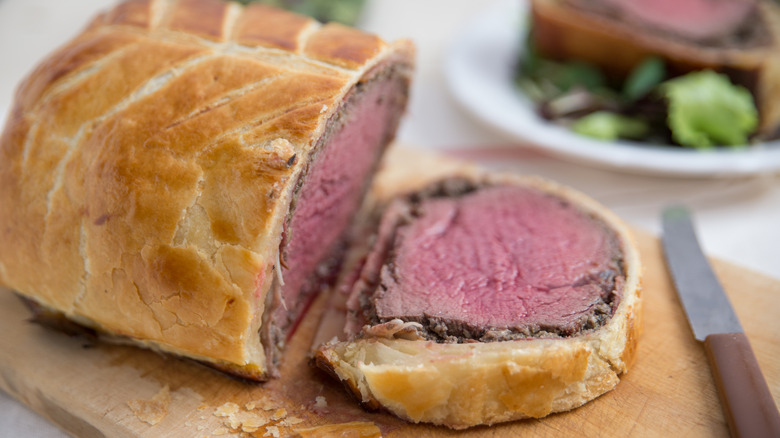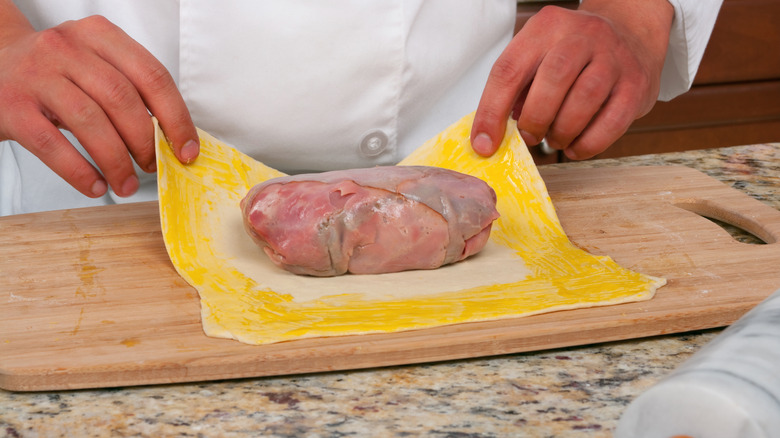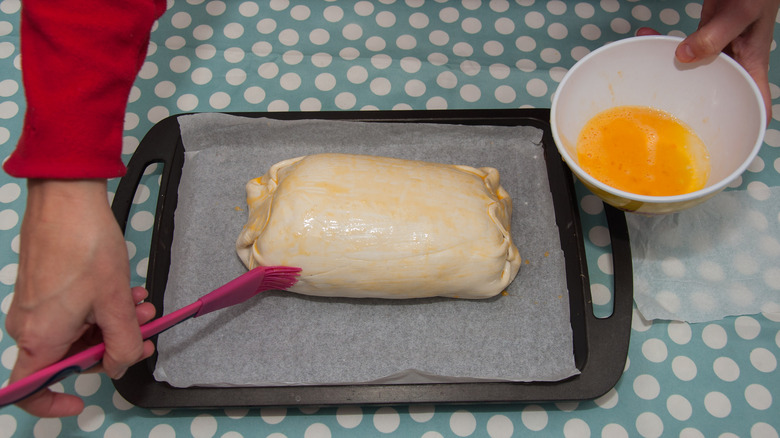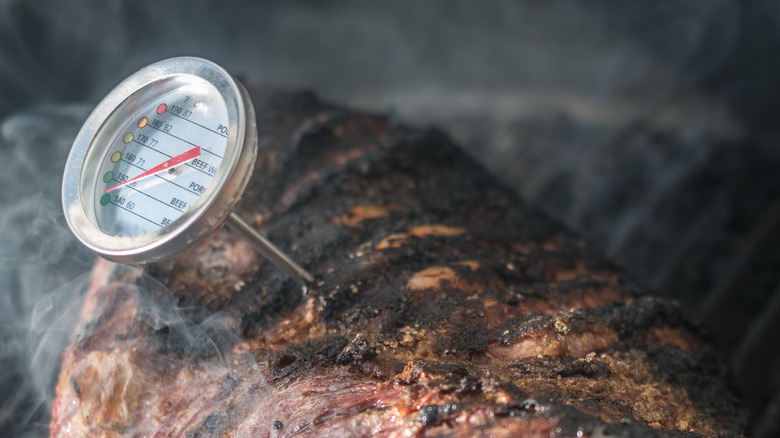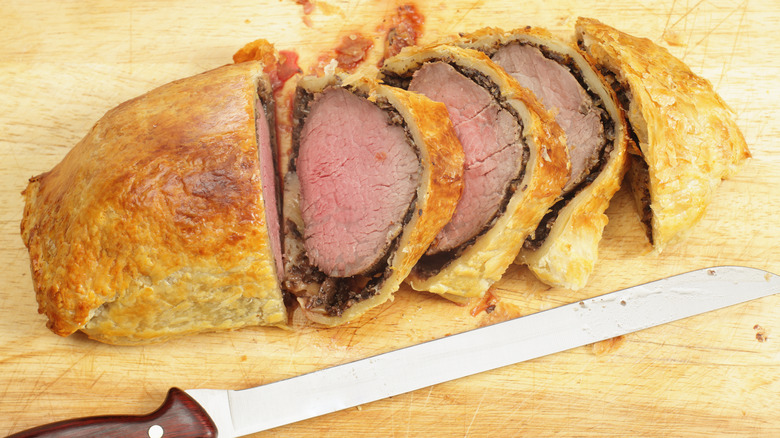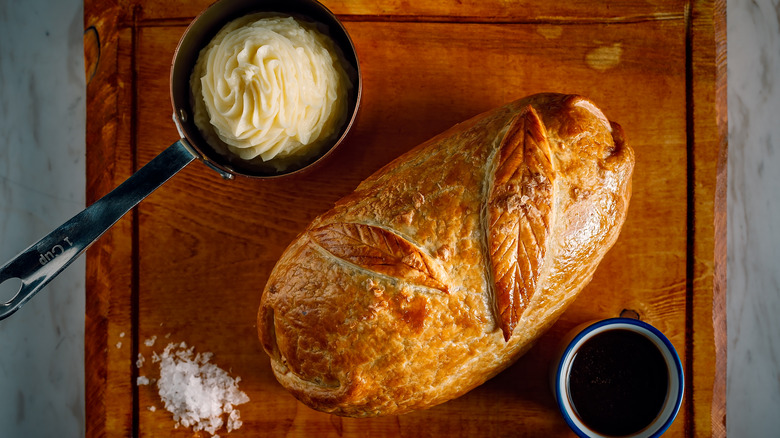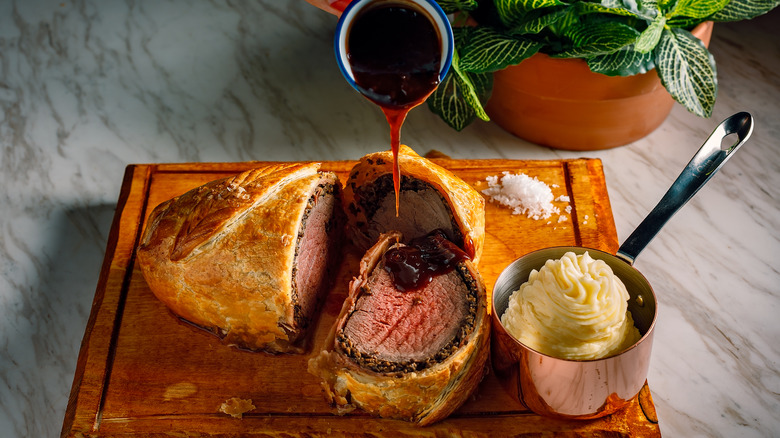Mistakes Everyone Makes When Cooking Beef Wellington
References to beef Wellington infiltrated American homes when celebrity chef Gordon Ramsay hurled insults at "Hell's Kitchen" contestants who undercooked the prized meat center of the dish. And perhaps it was the self-declared "Ambassador to Wellington" who put this seemingly elaborate, time-consuming, and fancy dish back on the American agenda (via The Washingtonian).
So, what is beef Wellington? According to Taste Atlas, beef Wellington is a traditional British delicacy made with beef sirloin, pâté, and mushroom duxelles wrapped in puff pastry and baked. The original beef Wellington was created and named for the Duke of Wellington, who stood victorious after the Battle of Waterloo in 1815 (via Gordon Ramsay Restaurants). Other Wellington experts argue the dish came from France, renamed in the U.K. after the French filet de boeuf en croute.
Today, beef Wellingtons are having a renaissance moment. This dish was a popular party item in the 1960s. These days, Wellingtons are often filled with prime seafood cuts, charred butternut squash, and mushroom mousse. More now than ever, at-home cooks are reaching for beef sirloin and puff pastry to try this British classic from scratch.
Making beef Wellington is all about precision, but with the right tips and tricks, a delicious and beautiful Wellington is undoubtedly achievable. And while several people attempt to make the famous dish, there are numerous cooking mistakes that can affect the quality of the final product.
Not cooking the mushroom mixture long enough
Soggy bottoms are the famous downfall of baked pastry: The term was used in 2010 by Paul Hollywood and Mary Berry on "The Great British Bake Off" (via The Telegraph). Now, home bakers and professionals fear the dreaded soggy bottom; a crisp golden brown bottom crust is the prime measurement of a successful bake.
Just as a soggy bottom doesn't suit an apple tart, it will also distract from a savory beef Wellington's regal appeal. Unfortunately, beef Wellington often falls victim to soggy pastry from excess moisture. The beef Sirloin juices are one explanation, but mushroom duxelles can also cause excess liquid to soak into the crust.
French duxelles is a mixture of sautéed mushrooms, shallots, and other aromatic seasonings that are finely chopped into a paste (via Collins Dictionary). According to the Harvard School of Public Health, mushrooms are 80-90% water.
So, to prevent excess moisture from seeping into the pastry, it is essential to eliminate as much excess liquid from the mushrooms as possible. Nigella Lawson advises cooking the mushroom mixture until all the moisture has evaporated. Lawson also blots them with paper towels to soak up any residual liquid.
Overstuffing the Beef Wellington with mushroom duxelles
Implementing proportions and balance is crucial for beef Wellington to be successful. Just as big globs of mayonnaise can alter a sandwich's proper ratio, beef Wellington adheres to a precise template, a layering from the inside out that requires all components to work in unison.
Celebrity chef Jamie Oliver understands that, in the case of Beef Wellington, too much of a good thing can exist. His mushroom duxelles is stuffed with sautéed onion, fresh herbs, a mushroom assortment, and chicken livers (via Twitter). But when it comes time to assemble his beef Wellington, he spreads the duxelles in an even layer, leaving at least an inch of space around the edges of the rolled-out puff pastry.
According to Oliver, this will ensure that the pastry sticks together and holds the meat and mushroom filling neatly inside. Otherwise, the filling will leak out, the pastry won't seal properly, and the baked beef Wellington will look untidy when it comes out of the oven.
Not bringing the meat to room temperature before searing
Cooking a piece of meat is more complex than throwing it in an oiled pan and browning it on all sides. Of course, seasoning is crucial (we'll get to that next), but there is a right way and a wrong way to prep your meat for the stovetop that has nothing to do with flavor. What's that step? Bringing your proud piece of beef Sirloin to room temperature before searing.
Putting cold meat in a hot pan is a no-go for multiple reasons. First, according to Teka, cooking the beef straight as it comes out of the refrigerator can affect the taste and the aroma. Instead, let it sit outside the fridge for up to an hour before searing to ensure a juicier and more tender steak. It also helps evenly cook a piece of meat.
Otherwise, you'll have an overcooked outer crust and an undercooked meat center. In the case of beef Wellington, bringing the Sirloin to room temperature will help ensure the pastry-covered meat remains juicy and evenly pink.
Not searing your sirloin first
Beef Wellington is a dish built on flavor layers. The butter pastry, umami mushroom duxelles, and at the center of it all, a beautifully seasoned, perfectly medium-rare piece of beef. As Top Chef alumni Carla Hall famously says, "There's flavor in the brown," and there is no truer statement when cooking proteins (via Bravo TV).
Even before the sear, liberally and evenly seasoning the beef Sirloin is essential to a flavorful Wellington. Celebrity Chef Jamie Oliver recommends seasoning a cutting board with salt, pepper, and chopped herbs (such as rosemary) and then rolling the sirloin in the coating to coat it evenly (via Twitter). The second layer of flavor development is left to a very hot pan.
There's a reason browned foods taste good, and it's easily explained by science. The Maillard reaction describes why foods that reach a minimum of 310 degrees Fahrenheit go through a chemical change. This chemical process explains why browning your beef Sirloin is so essential as a flavorful foundation for your beef Wellington.
Not chilling the pastry-wrapped Wellington
Temperature is key to a successful beef Wellington. Because there are so many components layered and wrapped, every part has to be cold for it to mold together properly (via Nigella Lawson's Website). Most importantly, the heat from a warm Sirloin or hot mushroom duxelles will melt the butter in the puff pastry.
As a result, according to Nigella Lawson, the Wellington will be harder to roll tightly, and the baked pastry will appear greasy. For this reason, all components must be cooled before assembling, and the puff pastry must be completely chilled before baking.
Lawson recommends chilling the seared beef Sirloin for 2-3 hours in the refrigerator before assembling a beef Wellington. After wrapping the meat in the puff pastry, Lawson chills the entire Wellington to ensure the butter in the pastry is cold. Conveniently, the chilled beef Wellington can go straight to the oven from the refrigerator.
Not wrapping the seared beef in a crepe layer
As mentioned before, undercooked mushrooms are a common cause of soggy pastry. But cooked meat releases natural juices that can also add moisture during cooking. Bringing the meat to room temperature before searing can help keep the juices inside, but even so, some excess liquid is bound to leak.
There are a few strategies for preventing the meat juices from turning the pastry soggy. Perhaps the most traditional is wrapping the seared beef and mushroom duxelles in crepes, which are thin pancakes (via Nigella Lawson's Website).
According to Nigella Lawson, the crepes soak up any excess moisture from the mushrooms and beef, allowing the puff pastry the opportunity to bake to its full, crispy potential. Alternatively, Gordon Ramsay swaps crepes for slices of prosciutto (via YouTube). Like the crepes, overlapped prosciutto slices contain extra juices, a double-duty ingredient that also adds salty ham flavor.
Wrapping the sirloin while it is still hot
Beef Wellington is all about the roll, and proper rolling technique is crucial to maintain a structurally sound and gorgeous final product. If it is not rolled tightly, a gap between the pastry and the mushroom-encrusted meat will drive a wedge between the two layers. Luckily, there's a quick fix to ensure a cohesive beef Wellington with no sagging pastry.
According to Certified Angus Beef, using plastic wrap to help roll your Wellington will help keep everything tight (via YouTube). First, a plastic wrap is placed underneath the rolled puff pastry, and the prosciutto-wrapped beef Sirloin is situated in the lower center of the pastry.
Next, chef Gavin Pinto uses the plastic wrap to lift the pastry over the beef while pressing to secure it firmly. At the very end, he wraps the pastry firmly around the meat as if wrapping a burrito. Then, the entire beef Wellington is tightly sealed with plastic wrap and left to chill before baking.
Skipping the egg wash
Tightly wrapping a beef Wellington will only serve you well if used with an egg wash. According to Masterclass, egg wash acts as a glue, holding pastry together while keeping the filling inside. Egg wash (a mixture of beaten egg with water or milk) helps bind two ingredients together or add a gorgeous golden brown exterior to baked pastry.
In the case of beef Wellington, the pastry's tight grip on the meat won't hold, thanks to the plastic wrap for expert rolling. Instead, the pastry will go rouge, the mushroom duxelles will peak through, and beef juices will run out the sides. After the Wellington is rolled and chilled, and before it goes in the oven, a final egg wash brush produces a beautiful glossy brown exterior after baking.
A final sprinkle of flaky sea salt will stick to the egg wash and add extra texture: Chef Gordon Ramsay uses this trick for flavor and a crisp pastry (via Gordon Ramsay Restaurants).
Not using an internal thermometer
The lure of beef Wellington essential comes down to the pastry and the meat. Is the puff pastry golden brown and crisp throughout? Is the beef Sirloin center rosy red with a dark sear barely visible beside against the pastry crust? Although an argument can be made for the pastry, beef Wellington's main event is the meat.
That means there's a lot of pressure to get it right, and much of that fuss has to do with achieving the proper internal temperature. According to MasterClass, using a thermometer will help achieve the perfect doneness without slicing into the meat (which is nearly impossible with beef Wellington anyways).
Even professional chefs can't rely on a sixth sense to check if a piece of meat is fully cooked. Chef Michael Symon swears by an instant-read thermometer to ensure all meats are cooked through but not overcooked (via Food Network).
According to Certified Angus Beef, a perfect medium-rare piece with a warm red center should read 135 degrees Fahrenheit. Instead of relying on luck and chance alone, insert an instant-read thermometer into the deepest part of the meat to get a proper read.
Slicing the beef Wellington with a dull knife
Beef Wellington is only as good as the equipment used to serve it. Imagine going through the entire process; searing the beef, chilling the meat, making the duxelles, wrapping the beef, chilling the beef again, rolling the pastry, wrapping it in the pastry, chilling one last time, and then, finally, baking it. It would be a shame for the indulgent centerpiece to arrive at the table, looking glam, only for the wrong knife to mangle it into a million pieces.
A sharp serrated knife is preferable for cutting beef Wellington. A serrated knife is best for cutting through bread and pastry without crushing or smushing. A super sharp chef's knife will also work if you don't have a serrated knife. Make sure to use a sawing motion to avoid crushing or pulling on the outer puff pastry layer. Take your time, working through the pastry and beef until the knife meets the cutting board.
Not letting it rest before slicing
Buttery, beefy smells are surely irresistible, but before diving straight in, give your Wellington a moment to decompress. Like all animal proteins, letting the meat rest for just a few minutes before slicing it can greatly impact flavor and texture.
Chef Angie Mar says resting meat is key to ensuring any protein stays juicy (via Martha Stewart). According to Mar, when meat is very hot, it is also very juicy. Cutting the meat when it is very hot will lead to all the juices escaping.
Allowing meat to rest just 10 minutes before slicing will give the juices time to redistribute, leaving more in your Wellington beef and less running onto the plate (via Gordon Ramsay Restaurants). During this resting time, the residual heat will continue to cook the beef Sirloin, so removing the Wellington a little while before it reaches the desired internal temperature will prevent it from overcooking.
Slicing the beef Wellington too thin
Before you start thinking, "what more could I possibly need to know about cooking beef Wellington," wait just a moment longer. There is yet a proper and improper way to slice beef Wellington, and the expert himself, chef Gordon Ramsay, is here to set the record straight.
According to Ramsay, slicing beef Wellington too thin can ruin the eating experience (via Gordon Ramsay Restaurants). Just as a dull knife will tear a Wellington into pieces, cutting paper-thin slices will compromise a beef Wellington's structural integrity.
Instead of a beautifully presented round of medium-rare beef encase in golden-brown pastry, you'll end up with a slice that will fall apart on the plate, which would be a true disservice to all the time and energy it took to assemble such an edible masterpiece. Ramsay recommends slicing beef Wellington about one inch thick to ensure the pastry stays firmly attached to the beef Sirloin.
